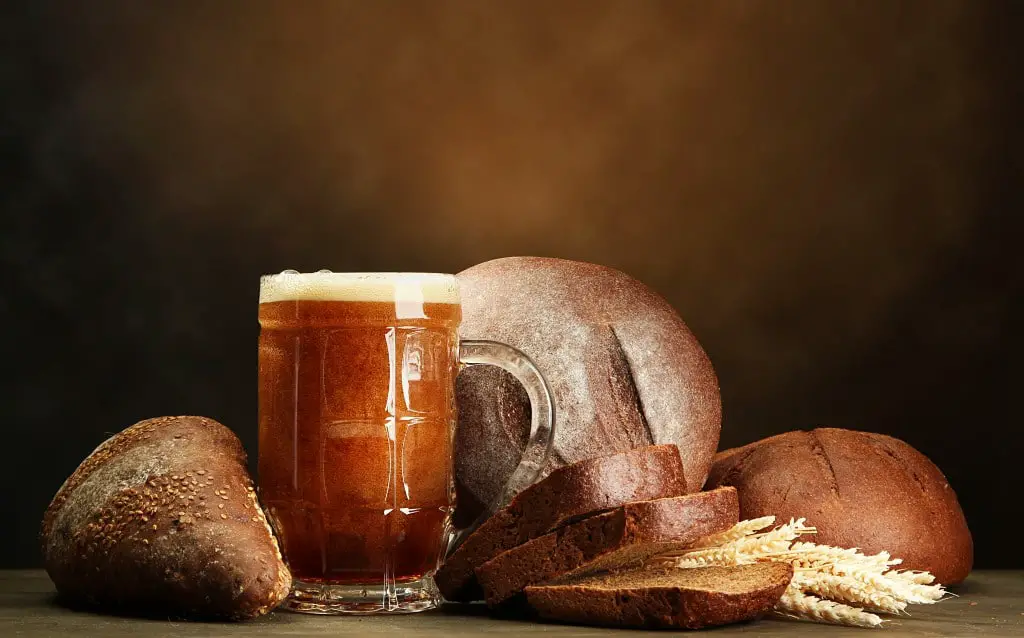Kvass (Квас) is sometimes referred to as “bread drink” or even “bread cider” in English. We recommend just sticking with the word “kvass,” though. Brewed from black or rye bread, the drink may come with a range of consistencies similar to those found in beer and a distinctly “bready” taste.
The first recorded mention of kvass in ancient Rus dates to 989 and is recorded in the Primary Chronicles, Russia’s oldest known written text. Here it is recorded that, when Kievan Prince Vladimir converted his subjects to Christianity he commanded that, in celebration, «раздать народу пищу, мед и квас» (food, honey, and kvass be distributed to the people).
Kvass is considered a national drink on par with vodka throughout much of the former Soviet Union.
Why It’s Called “Kvass”
(Почему так называется?)
The word “kvass” is from ancient Russian, meaning “sour.”
While the noun is now generally used only for the name of the drink, adjectival forms taken from the verb “кваситься” (to ferment) can still be regularly encountered in modern Russian. “Простокваша” (prostokvasha), for instance, is a sour milk drink whose name translates to “simply-soured.” Russians also eat a form of sauerkraut called “квашеная капуста” (sour cabbage).
Kvass is primarily drunk in summer and is revered for its “способность освежить в жаркий день” (ability to refresh on a hot day). While kvass is available in stores all year round, sales during winter months are negligible while in summer, kvass sales rise to over 30% of Russia’s non-alcoholic beverage market.
The Soviets produced kvass on an industrial level. A street vendor would sell it from an “огромная металлическая бочка” (giant metal keg) by the mugful, wiping out the mug after each shot. These vendors can still be seen throughout Russia and some Central Asian states, although they are usually now equipped with “одноразовые пластиковые стаканчики” (disposable plastic cups).
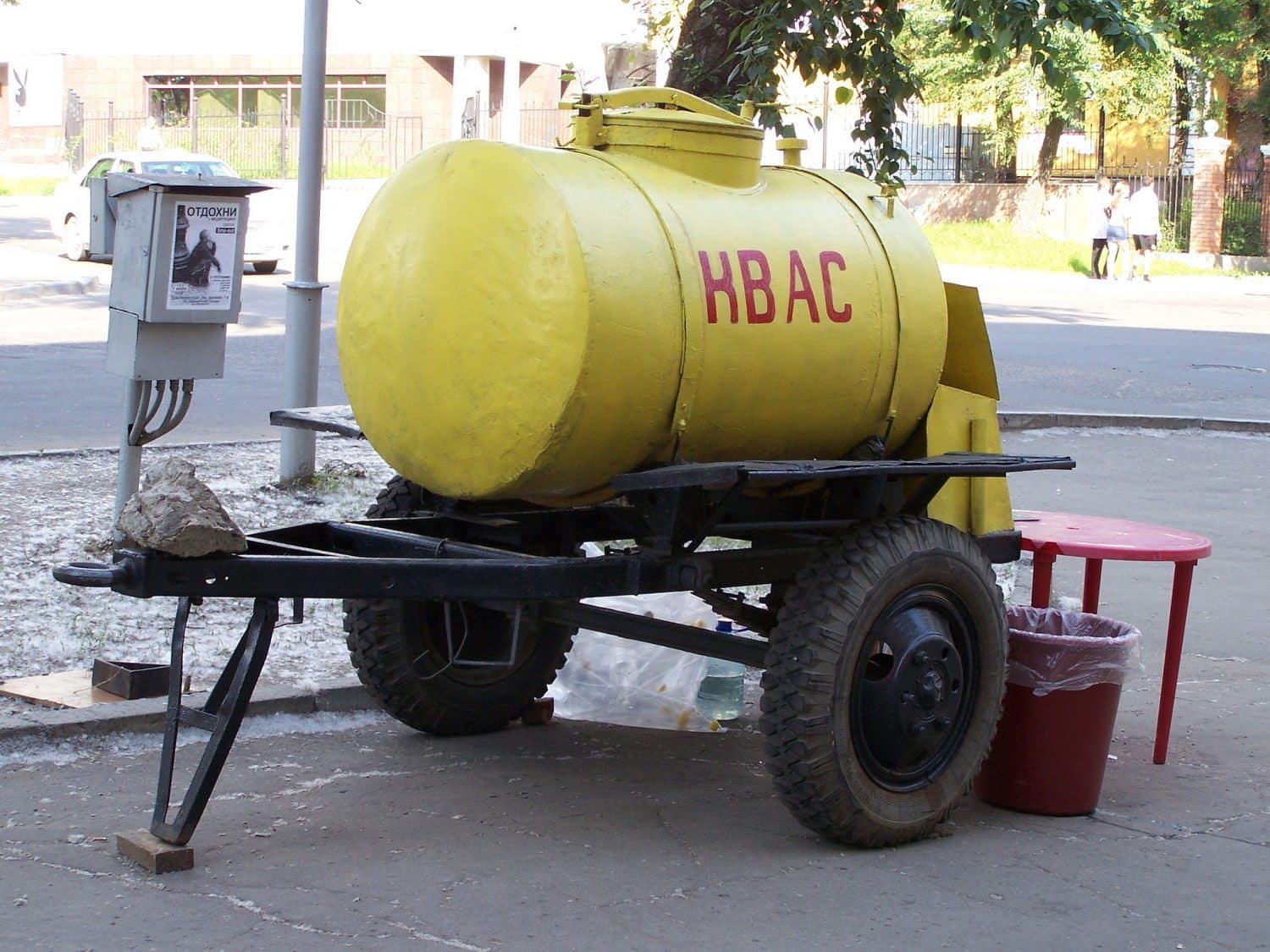
Despite its availability on Soviet streets, kvass was long known best as a “напиток, изготовленный в домашних условиях” (homemade drink). Soviet wives and grandmothers often “гордились своими собственными “секретными рецептами” (prided themselves on their own “secret recipes”).
It has always been known as a “people’s drink:” cheap, relatively easy to make, and popular. This is shown in the saying «Щи с мясом, а нет — так хлеб с квасом» meaning that even something as delicious (and luxurious a few centuries ago) as cabbage soup with meat is nothing compared to the basic pleasures of bread and kvass.
The status of квас as a national staple is further emphasized by «Кабы хлеб да квас, так и все у нас» (If there is bread, there is квас, all we need is with us.)
Kvass has a high caloric value, contains significant quantities of “витамины B1 и Е, также как и аминокислоты и микроэлементы” (vitamins B1 and E, as well as amino acids and micronutrients trace elements). It is known to “придает энергии и регулирует обменные процессы организма” (energize and regulate the body’s metabolic processes). It prevents the reproduction of harmful microbes, and positively influences the cardiovascular system.
Although it still holds a traditional place in Russian life, kvass is now most often purchased bottled in stores. Due largely to its primary product, квас, the Russian brewer Ochakavo holds third place in Russian beverage sales by value, after Coca-Cola and Pepsi (both of which also sell kvass in Russia).
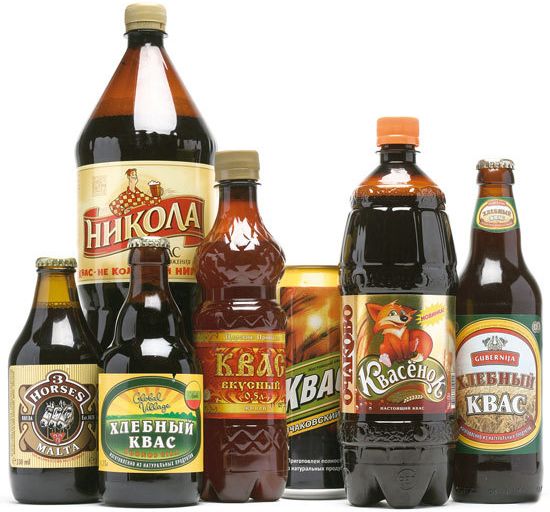
While most Russians consider kvass distinctly Russian, “появление кваса уходит своими корнями в глубокую древность” (kvass can trace its roots to ancient history). The ancient Egyptians, besides brewing beer, also brewed квас and types of fruity kvass are mentioned in the historical records of ancient Babylon.
The word “kwas” is also found in a number of other Slavic languages – in Polish, where it means “sourness,” in Czech and others.
When to Drink Kvass
(Как правильно пить квас?)
Kvass is most often “употребляется при комнатной температуре или слегка охлажденным” (served at room temperature or slightly chilled). It is never served with ice. Kvass is most often drunk in the summer – but can be found year-round.
How to Make Kvass
(Как правильно готовить квас?)
“Квас содержит небольшое количество алкоголя” (Kvass contains small amounts of alcohol), as does any drink involving the use of yeast. Root beer, also traditionally a brewed drink, also contains traces of alcohol, although, like kvass, rarely more than 0.5% to 1.5%. It is not recommended for children under the age of three to drink kvass (or traditional root beer).
“Закваска” (Kvass fermentation starter) is sold in Russia, which contains yeast and malt, but both ingredients can be easily obtained in America in local brew shops or even online.
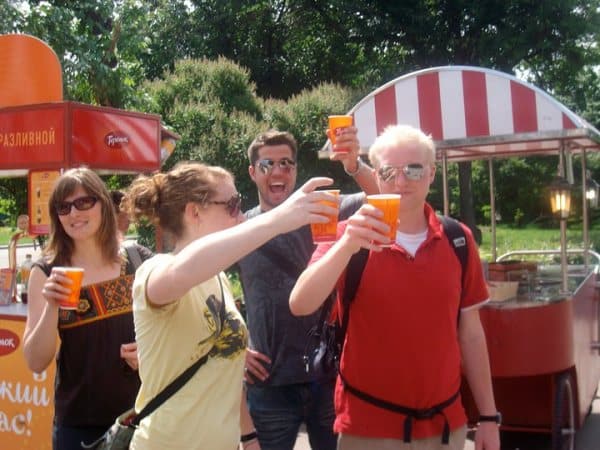
“Пивные дрожжи или дрожжи для шампанского” (Brewer’s or Champagne yeast) is recommended to use, as it will dissolve easily and fully, creating a smother drink.
The water used to make kvass is usually boiled and then the sugar added to create a syrup. The kvass can be flavored at this time by boiling the water with “мята, семена тмина, лимон, мед, ягоды, изюм или другие сухофрукты” (mint, caraway seeds, lemon, honey, berries, raisins or other dried fruit). While boiling is recommended, make sure that the water has cooled before adding the yeast. “Дрожжи испортятся, если их добавить в кипящую воду” (Adding yeast to boiling water will kill it) and the kvass will not ferment or carbonate properly.
When filling the bottles, make sure not to overfill them. Leave some space at the top for the gas to collect “чтобы бутылка не взорвалась” (so that the bottle doesn’t explode). Always store the bottles upright – as the pressure builds, “бутылки могут протечь” (the bottles can leak) if they are not upright.
Kvass Recipes
(Давай Приготовим!)
See below for a free recipe for various versions of Russian kvass. See also the free videos online. If you are interested in cooking from Russia, Ukraine, Georgia, and other places in Eurasia, make sure to see our full, free Eurasian Cookbook online! You might also be interested in the following specialized cookbooks we’ve enjoyed:
 |
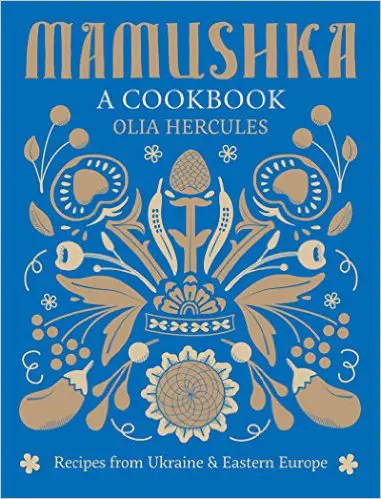 |
 |
 |
| Квас «Русский» (красный) | Russian Red Kvass |
Ингредиенты
Приготовление
|
Ingredients
Preparation
|
| Белый квас | White Kvass |
Ингредиенты
Приготовление
|
Ingredients
Preparation
|
Our Favorite Kvass Commercials
A commercial based on Nikola’s former ad campaign calling for Russians to drink kvass because it was “nikola” (not cola). Coke and Pepsi appealed to Russia’s advertisers’ union and had the campaign pulled, saying that it unfairly marketed against their products.
This bizzare little commercial is from Ochakovo, a company that makes good kvass and legendarily bad advertisements. Here, a group of tourists gawking at the architectural marvels of Los Angeles has one of their number saved by some guy who happens to have a couple large cans of kvass on him. And then he gets the girl too! Ooh, how refreshing!
You Might Also Like
Kupala is an ancient Slavic holiday celebrating the summer solstice, or midsummer. Once part of a series of annual rituals, it marked and was believed to sustain agricultural cycles—essential to early human survival. Held as vitally important, these pagan traditions remained deeply rooted even after Christianization, technological change, and centuries of oppression tried to dislodge […] Easter breads such as kulich, paska, choreg, and nazuki are delicious Easter traditions. Easter is by far the most important religious holiday for those practicing Eastern Christianity. In addition to church services and egg dying, the holiday is also marked across the cultures by ritual bread baking. Despite the wide geographic area covered by Eastern […] Below, Tajik blogger Roxana Burkhanova describes, in Russian, the place of St. Petersburg in Russian culture. She discusses the city’s history as well as its literary heritage, its nightlife, and even how people from Petersburg speak their own, slightly different dialect of Russian. The text was originally written in 2015 and thus references times before […] Rites of welcoming spring and saying goodbye to winter are some of the oldest holidays preserved across Slavic cultures. In the Baltics, the celebrations were nearly lost after being suppressed by Catholic and imperial dominance. Today, Russia’s Maslenitsa is by the far the best-known, but multiple versions exist across the diverse Slavic landscape. In the […] This extensive list of web resources to assist students learning the Russian language was developed by SRAS and is now hosted on Folkways, part of the SRAS Family of Sites! Disclosure: Some of the links below are affiliate links. This means that, at zero cost to you, we will earn an affiliate commission if you […]
Kupala: Ancient Slavic Midsummer Mythology and its Modern Celebration

Kulich, Paska, Nazuki: The Easter Breads of Eastern Christianity
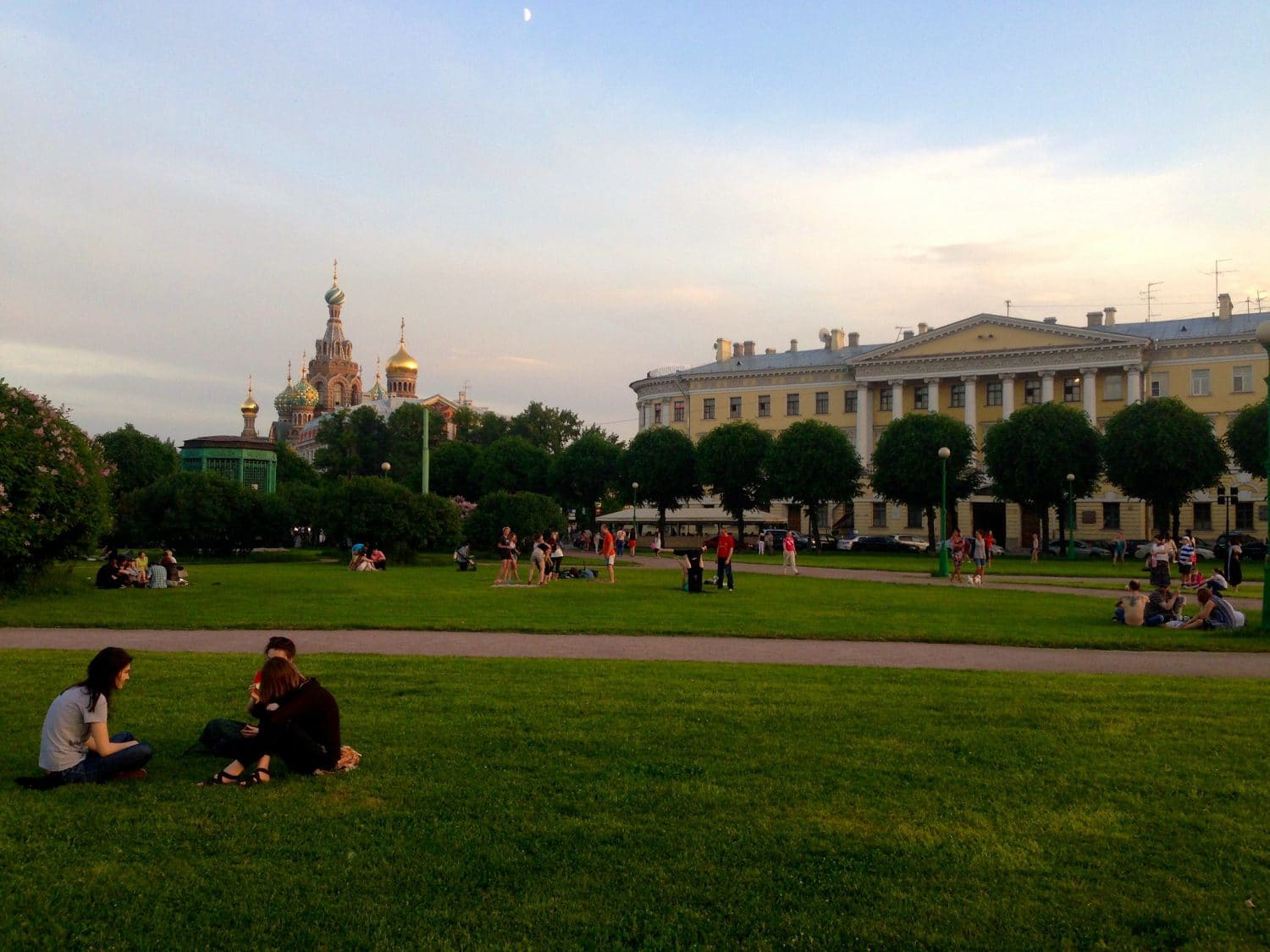
Off to Petersburg, Russia’s Cultural Capital: Моя Россия Blog
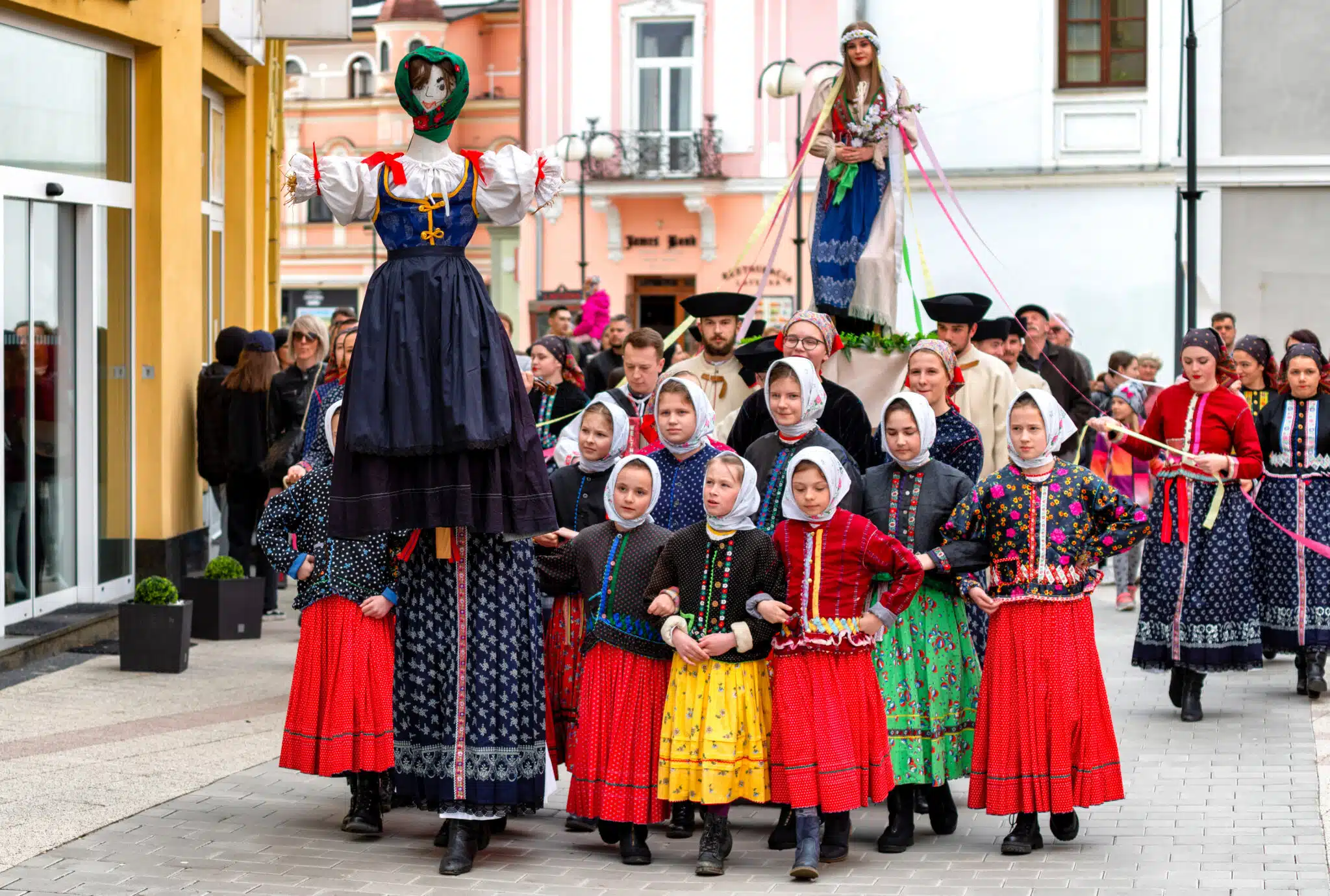
Maslenitsa, Masliana, Meteņi: Spring Holidays of the Slavs and Balts
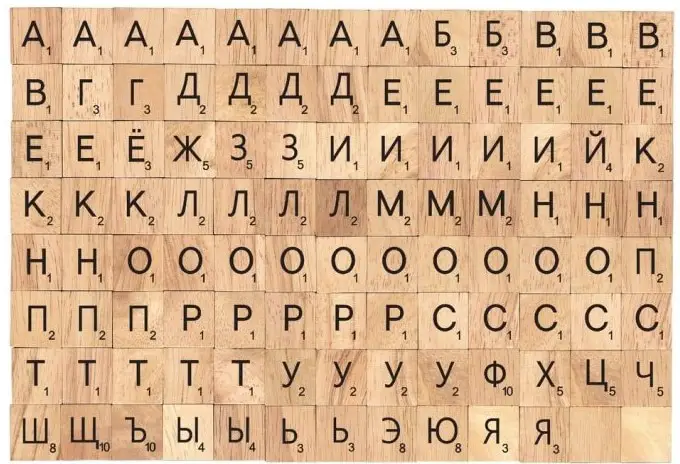
Resources for Students of Russian

